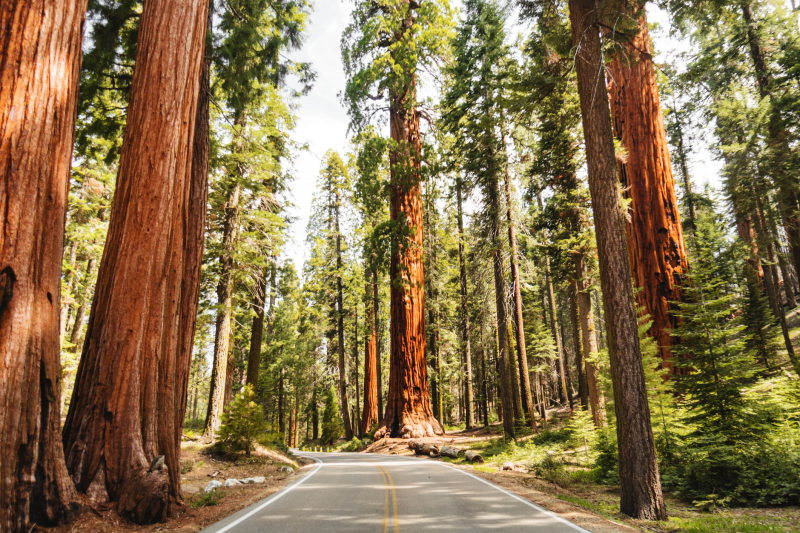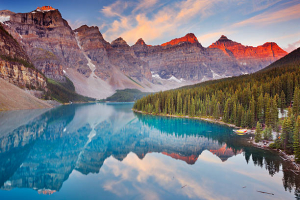Top 10 Best National Parks in the US
Today, the United States' national parks attract millions of visitors each year to unique natural wonders and unforgettable terrains. Toplist has considered ... read more...the opinions of both travel experts and recent park visitors to determine the best U.S. national parks. So, let's find out the best national parks in the US in this article with Toplist!
-
Yellowstone National Park is an outdoor enthusiast's dream, with its dramatic peaks and pristine lakes. Multicolored pools swirl around hot springs, verdant forests weave through vast meadows, and erupting geysers shoot streams of steaming water into the sky. There is no doubt that the park is now extraordinary. Be prepared to share the trails with permanent residents such as buffalo, elk, and even grizzlies as you traverse its 3,000-plus square miles of mountains, canyons, geysers, and waterfalls.
Although Yellowstone receives over 4 million visitors each year, chances are you won't see many of them unless you spend your entire trip at Old Faithful. Yellowstone's 2.2 million acres stretching from Wyoming's northwest corner to the borders of Idaho and Montana, providing plenty of unexplored territories to explore. Take a day or two to enjoy the scenery at Yellowstone Lake and Mammoth Hot Springs. But save some time for the trails through lesser-known areas, such as the West Thumb Geyser Basin's hot springs and the untamed wildlife on the Lewis River Channel and Dogshead Loop. While the sheer number of trails and wildlife-watching opportunities may appear overwhelming at first, keep in mind that you can always return.

Yellowstone 
Yellowstone -
Yosemite National Park, one of California's most formidable natural landscapes, features nearly 1,200 square miles of sheer awe: towering waterfalls, millennia-old sequoia trees, striking, intimidating cliff faces, and some of the country's most unique rock formations. Despite its immense size, the majority of tourist activity occurs within the 8-square-mile area of Yosemite Valley. The park's most famous landmarks – Half Dome and El Capitan – are located here, as are excellent hiking trails through the natural monuments.
Even inexperienced hikers can enjoy Yosemite: local adventure outfitters offer guided tours and climbing lessons. Just don't expect to be able to experience it on your own. Crowds are the biggest impediment to an enjoyable Yosemite vacation, as they are in so many other American tourist destinations – approximately 4 million people visit each year. However, if you go at the right time (and begin your day a little earlier than usual), Mother Nature's wonders will reveal themselves to you in a miraculous and serene way.

Yosemite 
Yosemite -
Glacier National Park, named after ice-age glaciers, is located on the border of Canada and Montana. Because of its dizzying array of natural beauty, it is often referred to as the "Crown of the Continent". The park is a popular destination for hikers, with trails for all skill levels ranging from the easy Trail of the Cedars (home to towering and beautiful cedars) to the difficult Grinnell Glacier (which offers sweeping views). Furthermore, the park contains over 700 lakes, numerous waterfalls, and two mountain ranges spread across more than 1 million acres, which provide habitat for a variety of wildlife.
Aside from its breathtaking geological features, it also has a rich history. The Going-to-the-Sun Road, a scenic 50-mile drive through the park, is a National Historic Landmark and an engineering marvel, providing spectacular views and access to popular hiking trails. Furthermore, many of the park's lodges, chalets, and hotels were built in the early twentieth century by the Great Northern Railway and are listed on the National Register of Historic Places.

Glacier National Park 
Glacier National Park -
This massive chasm in northern Arizona is truly a natural wonder, measuring approximately 277 river miles in length, up to 18 miles in width, and a mile deep. For 6 million years, the Grand Canyon has grown with the help of the mighty Colorado River, and for centuries, visitors from all over the world have come to marvel at its red and orange splendor. The Grand Canyon, which is managed by the National Park Service and is officially designated as a UNESCO World Heritage Site, awes its approximately 6 million visitors each year.
However, if you're looking for a secluded getaway to Mother Nature, you should be prepared: The Grand Canyon can become extremely crowded. The South Rim, which is home to the Grand Canyon Village and the well-worn Bright Angel Trail, is especially popular with visitors and hikers. The majority of the amenities are located on this side. Head to the North Rim to get away from the crowds. This is the place to go for backcountry camping and strenuous hiking. Consider taking a helicopter tour for an unforgettable view of the canyon.

Grand Canyon 
Grand Canyon -
Zion National Park, named after the Hebrew word for "refuge", is no longer the peaceful haven it once was in Utah's southwest corner. The park is now one of the most popular in the country, with over four million visitors each year. It's as if visitors have discovered a hidden treasure and can't get enough of the apricot-colored Zion Canyon, which they can see while wading through its Virgin River or ascending Angels Landing, with each bend in the river or turn in the trail providing an even more breathtaking view.
Furthermore, the blanket of stars that illuminates the night sky is a welcome end to a day full of active pursuits. And when it's time to return to reality from the refuge, the 166-mile drive from Las Vegas or the 308-mile drive from Salt Lake City is just about the right amount of time to process all the beauty you've just witnessed. The best time to visit Zion National Park is between April and November when the park's free shuttles run and the weather is pleasant.

Zion National Park 
Zion National Park -
Wyoming's majestic Teton Mountains, towering above Jackson Hole Valley with jagged snow-capped peaks, are in high relief at Grand Teton National Park. The photo opportunities abound, from the 13,770-foot Grand Teton to the glistening Jenny and Jackson lakes, which reflect the mountains in their depths. However, the park isn't just for hikers and photographers. During the peak summer season, the area's trails beckon hikers of all abilities, revealing hidden waterfalls and breathtaking views of the Tetons. Meanwhile, the Snake River attracts kayakers, rafters, and those looking for a relaxing float. Historic districts such as Menors Ferry and Mormon Row draw history buffs interested in the Western Frontier's 19th-century past.
The nearly 500-square-mile park also has a diverse wildlife population, including black bears, grizzlies, moose, antelope, and bison. In addition, during the autumn season, visitors can see the park lit up with golden aspens. Travelers who want to visit another national park while in Grand Teton can drive a few miles north to Yellowstone, which is adjacent to Grand Teton.

Grand Teton National Park 
Grand Teton National Park -
Bryce Canyon National Park, located in southwestern Utah, has an otherworldly landscape made up of a dozen amphitheaters, or horseshoe-shaped canyons, on an eroded escarpment of the Paunsaugunt Plateau. Visitors who enjoy exploring the slot canyons, windows, fins, and, most notably, the tall, skinny spires known as hoodoos are drawn to the whimsical formations of limestone rock created by erosion and rain. Bryce Canyon, with elevations reaching 9,115 feet, provides approximately 150 miles of visibility on a clear day. Furthermore, because it is exposed to very little light pollution, the park provides ideal conditions for stargazing.
Bryce Canyon National Park is best visited between May and September. This time of year not only has the warmest weather of the year, but it also has a plethora of ranger activities. October through April has its own set of charms. There are fewer people, the weather is cooler, and the fall foliage and wildflowers can be breathtaking. Snow transforms the park in the winter, and visitors can go cross-country skiing and snowshoeing. But keep in mind that, due to its high elevation, the weather at Bryce Canyon can be quite variable in the fall, winter, and spring.

Bryce Canyon National Park 
Bryce Canyon National Park -
Traveling to Arches National Park is like visiting another planet, one with thousands of natural sandstone arches, red rocks and landforms in incredible formations, and light that appears to change at any moment. The way the shadows play across the arches makes the park particularly appealing to photographers, who are drawn to capturing its enchanting vistas, especially at dawn and dusk. But Arches National Park is more than just a photographer's dream.
The park, located 5 miles northwest of Moab, Utah, has 26 miles of scenic road and hikes for all levels of fitness. Hikers can choose from a variety of trails, ranging from short 20-minute walks to Balanced Rock and the Double Arch to longer and more difficult treks through the Fiery Furnace and up to Delicate Arch. When you need to return to Earth, simply look up: the Colorado Plateau has some of the darkest skies in the contiguous United States, allowing for spectacular views of the Milky Way.

Arches National Park 
Arches National Park -
Rocky Mountain National Park, at approximately 265,000 acres, is not the country's largest national park, nor is it the most visited, with approximately 4 million visitors per year. However, there is something truly magical about RMNP, which rises 14,259 feet into the Colorado sky at its highest point, Pikes Peak. Hiking the park's 350-plus miles of trails through pine and spruce forests, glittering alpine lakes, swaths of wildflowers, and, if you're lucky, some elk or bighorn sheep is the main draw. And, perhaps it's the thinner air that gets to people's heads, but even the most jaded visitors report feelings of awe and wonder after a day or two of breathing in that fresh mountain air.
When it's time to return to earth, or at least to an elevation of 7,500 feet or so, visitors can eat some homemade ice cream, take a spooky tour of the Stanley Hotel, or simply meander through Estes Park's charming village. Furthermore, neighboring Colorado hotspots Boulder and Denver are only a short drive away.

Rocky Mountain National Park 
Rocky Mountain National Park -
Sequoia National Park is awe-inspiring because it is home to some of the world's tallest trees. It's easy to feel small in comparison to the park's magnificent trees, which tower hundreds of feet above you. The park, which is located about 80 miles east of Fresno, California, in the southern Sierra Nevada mountain range, was established in 1890 to protect the giant trees from logging, making it America's second national park. The adjacent Kings Canyon National Park was established in 1940, and the two parks eventually became linked.
The trees are, of course, the park's main attraction. The General Sherman Tree, which has rightfully earned the title of the world's largest tree, is perhaps the most notable (it stands 275 feet tall and its base measures more than 36 feet in diameter). Beyond admiring the park's flora, there's plenty to see and do, including cave exploration, hiking, and snowshoeing. Furthermore, the park is open every day of the year, with different attractions for each season.

Sequoia National Park 
Sequoia National Park































